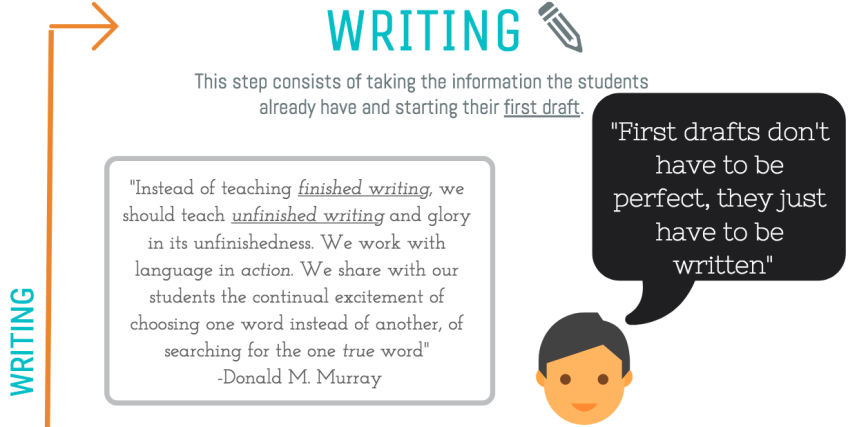
This post is the third in a series about our class project in “Teaching Composition.” Read Part One and Part Two.
 When I designed an infographic assignment for students in my “Teaching Composition” class last semester, I hoped it would be directly applicable to the careers of the students in the course. A number of the students are majoring in Education with an English Language Arts concentration, planning to be teachers. Although I myself have taught a smidgen of high school English, my training and experience have been almost entirely focused on the college classroom. Working with the future teachers in our class would, as the cliche goes, allow me to learn as much from my students as they learned from me. One thing we quickly noticed was the relative gap in information about writing pedagogy for middle- and high-school students. So much of the research in composition studies emerges from and addresses the college classroom. So we took up the task of adapting and translating research on the writing process for younger students–keep freewriting; toss most of the greek terms. One thing that is especially useful for writers at any level? The notion that writing is a process, not a product.
When I designed an infographic assignment for students in my “Teaching Composition” class last semester, I hoped it would be directly applicable to the careers of the students in the course. A number of the students are majoring in Education with an English Language Arts concentration, planning to be teachers. Although I myself have taught a smidgen of high school English, my training and experience have been almost entirely focused on the college classroom. Working with the future teachers in our class would, as the cliche goes, allow me to learn as much from my students as they learned from me. One thing we quickly noticed was the relative gap in information about writing pedagogy for middle- and high-school students. So much of the research in composition studies emerges from and addresses the college classroom. So we took up the task of adapting and translating research on the writing process for younger students–keep freewriting; toss most of the greek terms. One thing that is especially useful for writers at any level? The notion that writing is a process, not a product.
This idea can totally reorchestrate students’ relationship to writing. Rather than see an essay as a single-step product in which they pour all their ideas, in order, onto the page, students can give themselves the time and space to develop ideas through brainstorming, drafting, and revising. The process of writing is one of “discovery through language,” and the writing classroom can become a space where teachers and students can share in “the continual excitement of choosing one word instead of another, of searching for the one true word.” Instead of performing smartness for an all-knowing teacher who decides, with the flick of her red pen, whether a student’s writing is good and correct or bad and wrong, students can work through their ideas, develop deeper thinking about their topic, and express what they believe to their readers.
Sounds wonderful, but how do we make it happen? Especially when we teach younger writers who have less experience developing their ideas in language? Two student groups in our class explored the writing process in their infographics, with one group, Hannah Karkos and Carolyn Lekousis aiming to teach middle- and high-school teachers how to teach the writing process. In their research, which they also presented at the 2018 St. Francis Writer’s Conference, they explored strategies for adapting process pedagogy for younger writers. Here’s how they went about creating their infographic:
As future Secondary Education teachers, Hannah and I wanted to focus on teaching writing and how current models should be updated and more flexible. Currently and in the past, most teachers seem to teach writing as a product to be turned in for a grade, increasing student’s anxiety with writing. In our infographic, we break down steps that can be used to teach writing in a less intimidating way and focus more on writing as a process than a product. The steps in our infographic can be done in different orders depending on the person, and are simply just the bones of writing. The steps that we came up with are a combination of stages from readings in our class and from a book that we used in one of our Education courses. After presenting our infographic to the class and weighing in on discussions with our classmates about other articles that addressed the writing process, we truly believe in taking these steps in writing and using them as a helpful reference. These steps can also be used with different grade levels, the teacher would just modify the steps to suit the students’ writing abilities. Overall, the different stages of the writing process that we listed (planning, organizing, writing, editing, revising) help reduce the stress of writing and give students a better perspective on how writing is a process and not something that happens overnight.
